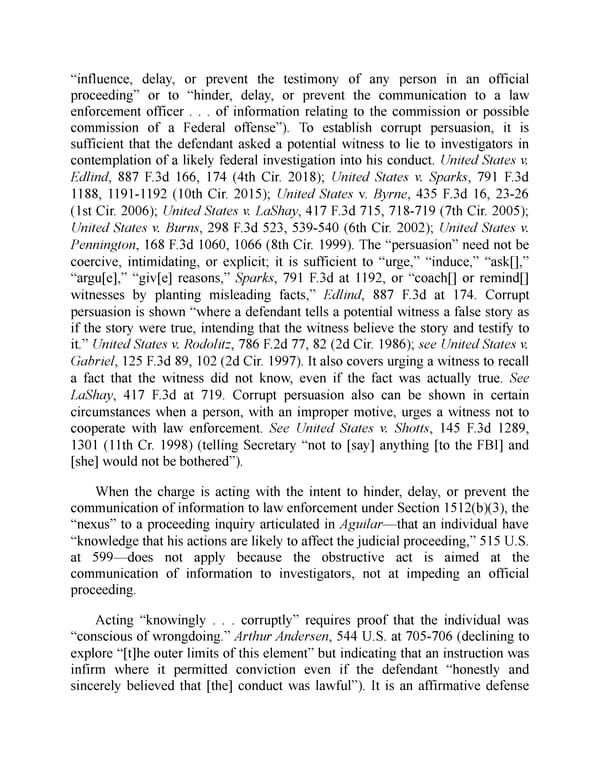“influence, delay, or prevent the testimony of any person in an official proceeding” or to “hinder, delay, or prevent the communication to a law enforcement officer . . . of information relating to the commission or possible commission of a Federal offense”). To establish corrupt persuasion, it is sufficient that the defendant asked a potential witness to lie to investigators in contemplation of a likely federal investigation into his conduct. United States v. Edlind, 887 F.3d 166, 174 (4th Cir. 2018); United States v. Sparks, 791 F.3d 1188, 1191-1192 (10th Cir. 2015); United States v. Byrne, 435 F.3d 16, 23-26 (1st Cir. 2006); United States v. LaShay, 417 F.3d 715, 718-719 (7th Cir. 2005); United States v. Burns, 298 F.3d 523, 539-540 (6th Cir. 2002); United States v. Pennington, 168 F.3d 1060, 1066 (8th Cir. 1999). The “persuasion” need not be coercive, intimidating, or explicit; it is sufficient to “urge,” “induce,” “ask[],” “argu[e],” “giv[e] reasons,” Sparks, 791 F.3d at 1192, or “coach[] or remind[] witnesses by planting misleading facts,” Edlind, 887 F.3d at 174. Corrupt persuasion is shown “where a defendant tells a potential witness a false story as if the story were true, intending that the witness believe the story and testify to it.” United States v. Rodolitz, 786 F.2d 77, 82 (2d Cir. 1986); see United States v. Gabriel, 125 F.3d 89, 102 (2d Cir. 1997). It also covers urging a witness to recall a fact that the witness did not know, even if the fact was actually true. See LaShay, 417 F.3d at 719. Corrupt persuasion also can be shown in certain circumstances when a person, with an improper motive, urges a witness not to cooperate with law enforcement. See United States v. Shotts, 145 F.3d 1289, 1301 (11th Cr. 1998) (telling Secretary “not to [say] anything [to the FBI] and [she] would not be bothered”). When the charge is acting with the intent to hinder, delay, or prevent the communication of information to law enforcement under Section 1512(b)(3), the “nexus” to a proceeding inquiry articulated in Aguilar—that an individual have “knowledge that his actions are likely to affect the judicial proceeding,” 515 U.S. at 599—does not apply because the obstructive act is aimed at the communication of information to investigators, not at impeding an official proceeding. Acting “knowingly . . . corruptly” requires proof that the individual was “conscious of wrongdoing.” Arthur Andersen, 544 U.S. at 705-706 (declining to explore “[t]he outer limits of this element” but indicating that an instruction was infirm where it permitted conviction even if the defendant “honestly and sincerely believed that [the] conduct was lawful”). It is an affirmative defense
 Mueller Report PDF Page 287 Page 289
Mueller Report PDF Page 287 Page 289